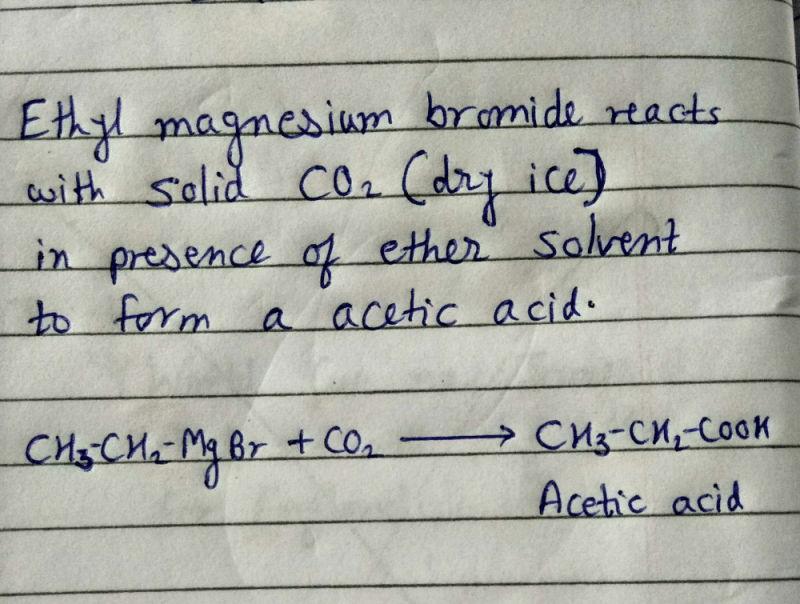NEET Exam > NEET Questions > CO₂ on reaction with ethyl magnesium bromide ...
Start Learning for Free
CO₂ on reaction with ethyl magnesium bromide gives
- a)Ethane
- b)Propanoic acid
- c)Acetic acid
- d)None
Correct answer is option 'B'. Can you explain this answer?
Most Upvoted Answer
CO₂ on reaction with ethyl magnesium bromide givesa)Ethaneb)Propanoic ...
Organic Chemistry involves the study of the reactions and properties of carbon-containing compounds. Carbon can form a vast number of compounds due to its unique bonding properties. In this question, we are given the reaction of CO with ethyl magnesium bromide.
Reaction of CO with Ethyl Magnesium Bromide:
CO (Carbon Monoxide) is a colorless, odorless, and toxic gas. It is a weakly acidic oxide of carbon that reacts with many compounds to form a variety of useful products. Ethyl magnesium bromide is an organometallic compound that is commonly used in organic synthesis. It is a strong nucleophile and can react with many carbonyl compounds.
The reaction of CO with Ethyl magnesium bromide proceeds as follows:
CO + EtMgBr → EtCOOMgBr
In this reaction, CO acts as an electrophile and is attacked by the nucleophilic carbon atom of the EtMgBr. The resulting intermediate, EtCOOMgBr, is a magnesium salt of acetic acid. This intermediate can be hydrolyzed to form acetic acid.
Hydrolysis of EtCOOMgBr:
EtCOOMgBr + H2O → EtCOOH + MgBrOH
In this step, the magnesium salt of acetic acid is treated with water to form acetic acid and magnesium hydroxide. Acetic acid is a colorless liquid with a pungent odor. It is a weak organic acid that can be used as a solvent, food preservative, and in the manufacture of various chemicals.
Therefore, the correct answer to this question is option B, acetic acid.
Reaction of CO with Ethyl Magnesium Bromide:
CO (Carbon Monoxide) is a colorless, odorless, and toxic gas. It is a weakly acidic oxide of carbon that reacts with many compounds to form a variety of useful products. Ethyl magnesium bromide is an organometallic compound that is commonly used in organic synthesis. It is a strong nucleophile and can react with many carbonyl compounds.
The reaction of CO with Ethyl magnesium bromide proceeds as follows:
CO + EtMgBr → EtCOOMgBr
In this reaction, CO acts as an electrophile and is attacked by the nucleophilic carbon atom of the EtMgBr. The resulting intermediate, EtCOOMgBr, is a magnesium salt of acetic acid. This intermediate can be hydrolyzed to form acetic acid.
Hydrolysis of EtCOOMgBr:
EtCOOMgBr + H2O → EtCOOH + MgBrOH
In this step, the magnesium salt of acetic acid is treated with water to form acetic acid and magnesium hydroxide. Acetic acid is a colorless liquid with a pungent odor. It is a weak organic acid that can be used as a solvent, food preservative, and in the manufacture of various chemicals.
Therefore, the correct answer to this question is option B, acetic acid.
Free Test
FREE
| Start Free Test |
Community Answer
CO₂ on reaction with ethyl magnesium bromide givesa)Ethaneb)Propanoic ...


|
Explore Courses for NEET exam
|

|
Similar NEET Doubts
CO₂ on reaction with ethyl magnesium bromide givesa)Ethaneb)Propanoic acidc)Acetic acidd)NoneCorrect answer is option 'B'. Can you explain this answer?
Question Description
CO₂ on reaction with ethyl magnesium bromide givesa)Ethaneb)Propanoic acidc)Acetic acidd)NoneCorrect answer is option 'B'. Can you explain this answer? for NEET 2025 is part of NEET preparation. The Question and answers have been prepared according to the NEET exam syllabus. Information about CO₂ on reaction with ethyl magnesium bromide givesa)Ethaneb)Propanoic acidc)Acetic acidd)NoneCorrect answer is option 'B'. Can you explain this answer? covers all topics & solutions for NEET 2025 Exam. Find important definitions, questions, meanings, examples, exercises and tests below for CO₂ on reaction with ethyl magnesium bromide givesa)Ethaneb)Propanoic acidc)Acetic acidd)NoneCorrect answer is option 'B'. Can you explain this answer?.
CO₂ on reaction with ethyl magnesium bromide givesa)Ethaneb)Propanoic acidc)Acetic acidd)NoneCorrect answer is option 'B'. Can you explain this answer? for NEET 2025 is part of NEET preparation. The Question and answers have been prepared according to the NEET exam syllabus. Information about CO₂ on reaction with ethyl magnesium bromide givesa)Ethaneb)Propanoic acidc)Acetic acidd)NoneCorrect answer is option 'B'. Can you explain this answer? covers all topics & solutions for NEET 2025 Exam. Find important definitions, questions, meanings, examples, exercises and tests below for CO₂ on reaction with ethyl magnesium bromide givesa)Ethaneb)Propanoic acidc)Acetic acidd)NoneCorrect answer is option 'B'. Can you explain this answer?.
Solutions for CO₂ on reaction with ethyl magnesium bromide givesa)Ethaneb)Propanoic acidc)Acetic acidd)NoneCorrect answer is option 'B'. Can you explain this answer? in English & in Hindi are available as part of our courses for NEET.
Download more important topics, notes, lectures and mock test series for NEET Exam by signing up for free.
Here you can find the meaning of CO₂ on reaction with ethyl magnesium bromide givesa)Ethaneb)Propanoic acidc)Acetic acidd)NoneCorrect answer is option 'B'. Can you explain this answer? defined & explained in the simplest way possible. Besides giving the explanation of
CO₂ on reaction with ethyl magnesium bromide givesa)Ethaneb)Propanoic acidc)Acetic acidd)NoneCorrect answer is option 'B'. Can you explain this answer?, a detailed solution for CO₂ on reaction with ethyl magnesium bromide givesa)Ethaneb)Propanoic acidc)Acetic acidd)NoneCorrect answer is option 'B'. Can you explain this answer? has been provided alongside types of CO₂ on reaction with ethyl magnesium bromide givesa)Ethaneb)Propanoic acidc)Acetic acidd)NoneCorrect answer is option 'B'. Can you explain this answer? theory, EduRev gives you an
ample number of questions to practice CO₂ on reaction with ethyl magnesium bromide givesa)Ethaneb)Propanoic acidc)Acetic acidd)NoneCorrect answer is option 'B'. Can you explain this answer? tests, examples and also practice NEET tests.

|
Explore Courses for NEET exam
|

|
Signup for Free!
Signup to see your scores go up within 7 days! Learn & Practice with 1000+ FREE Notes, Videos & Tests.
























